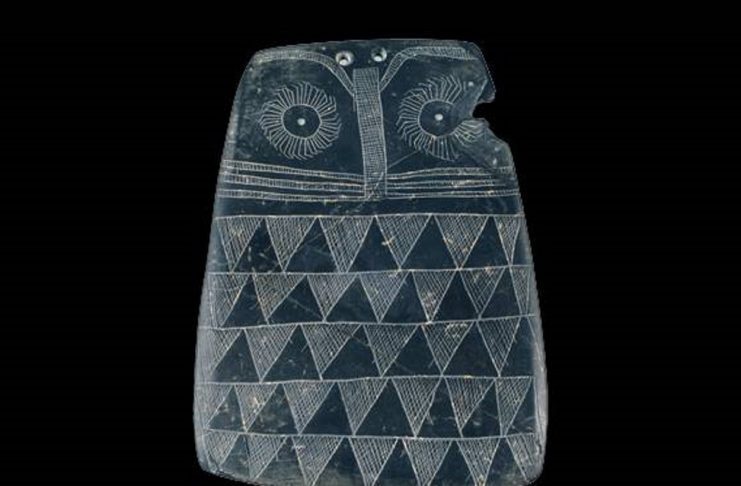
© EBD-CSIC
Over 4,000 owl-like slate plaques have been found at burial sites in the south-western Iberian Peninsula. They date from a period between 5,400 to 4,750 years ago, often sharing several characteristics, such as engraved circles as eyes, and an outlined body at the bottom representing the plumage of an owl.
Researchers have theorised for more than a century about the origin and purpose of the plaques. They were through to have a ritual significance, possibly to represent deities or the deceased.
A study in the journal
Scientific Reports by Juan José Negro, a researcher at the Higher Council for Scientific Research (CSIC) at the Doñana Biological Station (EBD), now suggests that the plaques were created by children using copper, flint or quartz tools, to depict owl species present in the region, and that they were likely used as dolls, toys or amulets.

© Negro, J.J., Blanco, G., Rodríguez-Rodríguez, E. et al.Selected plaques engraved in the Chalcolithic period in the southwestern portion of the Iberian Peninsula. These examples provide a glimpse of the different typologies and materials used (not at scale). (a) Slate plaque from Cerro de las Cabezas, Valencina de la Concepción, Sevilla, Spain (Museo Arqueológico de Sevilla, REP25837). (b) Slate plaque from anta do Curral da Antinha, Arraiolos, Evora, Portugal (Museu Nacional de Arqueologia de Portugal [MNA], Lisboa, 2003.37.1). (c) Slate plaque from anta 1 da Farisoa, São Marcos do Campo, Reguengos de Monsaraz, Evora, Portugal (MNA, Lisboa, 32300). (d) Slate plaque with carved head from anta da Marquesa, Marvão, Portalegre, Portugal (MNA, Lisboa, 8195). (e) Slate plaque from anta Grande do Olival da Pega, Reguengos de Monsaraz, Evora, Portugal (MNA, Lisboa, 985.45.21). (f) Slate plaque from anta Grande do Olival da Pega, Reguengos de Monsaraz, Evora, Portugal (MNA, Lisboa, 985.45.15). (g) Sandstone plaque from anta da Horta, Alter do Chão, Portoalegre, Alentejo, Portugal (Museu da Coudelaria de Alter, Portugal, AH 197). (h) Oculated idol carved on proximal phalanx of ungulate from Huerta de Dios, Casas de Reina, Badajoz, Spain (Museo Arqueológico Provincial de Badajoz, 11425).
Negro and his team analysed 100 plaques and ranked them based on how many distinct features of the owls were depicted. They then compared the results with 100 drawings made by children between the ages of 4 and 13 and observed the similarities.
"We propose these plaques may have resulted from children playing - though we cannot put an age to it," says Negro. "This is not incompatible with the idea that the plaques may also have then been used in rituals as burial offerings."
Many of the plaques have two holes at the top, which the team deems impractical for threading string to hang them as ritual objects. Instead Negro suggests that the holes were used to insert feathers, representing the feathered tufts, similar to ears, that some species of owls present in the area have on their heads, such as the long-eared owl or
Asio otus.Reference: Negro, J.J., Blanco, G., Rodríguez-Rodríguez, E.
et al. "Owl-like plaques of the Copper Age and the involvement of children".
Science Reports 12, 19227 (2022).
doi.org/10.1038/s41598-022-23530-0





I’ll take Talisman / Shamanistic totemic animal spirit amulet’s for $300 Alex please.
Ritualistic - Talisman - Shamanistic - totemic animal spirit guides - religious cultural guardian amulet’s - adornments to protect or guide children from evil spirits to see in darkness. Owls were thought for several reasons to be psychopomps that led them into the spirit world/other realms.The parents most likely traded or purchased for them. The duality triangle of life/death is easily distinguishable.